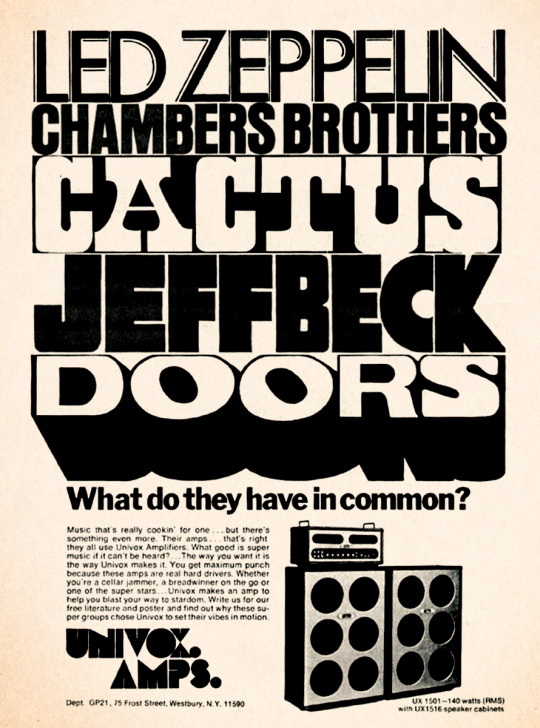#univox guitar amplifiers
Explore tagged Tumblr posts
Text

Univox amplifiers ad - 1973.
#vintage illustration#vintage advertising#typography#vintage typography#hand lettering#univox#univox amplifiers#amplifiers#guitar amplifiers#vintage amplifiers#vintage guitar amplifiers#led zeppelin#the doors#jeff beck#the chambers brothers#rock music#classic rock#musicians#guitarists#rock guitar#rock guitarists#musical equipment#univox guitar amplifiers#univox guitar amps#the 70s#the 1970s#1973
32 notes
·
View notes
Text

Kurt was described as a happy and excitable child, who also exhibited sensitivity and care. His talent as an artist was evident from an early age, as he would draw his favorite characters from films and cartoons, such as the Creature from the Black Lagoon and Donald Duck, in his bedroom. He was encouraged by his grandmother, Iris Cobain who was a professional artist.
Cobain's family had a musical background, and he developed an interest in music early and began singing at the age of two. At age four, he started playing the piano and singing, writing a song about a trip to a park. He listened to artists including Electric Light Orchestra (ELO), and, from a young age, would sing songs including Arlo Guthrie's "Motorcycle Song", the Beatles' "Hey Jude", Terry Jacks' "Seasons in the Sun", and the theme song to the Monkees television show.
On his 14th birthday Kurt's uncle offered him either a bike or a used guitar; Kurt chose the guitar. It was an electric guitar from Sears and he took guitar lessons long enough to learn AC/DC's "Back in Black".
Upon forming what would be Nirvana, he was playing a Fender Champ amplifier and a righthanded Univox Hi-Flier guitar that he flipped over and strung for lefthanded playing.
Kurt Donald Cobain died April 5, 1994 at the age of 27. ~He is highly recognized as one of the most influential alternative rock musicians.
#kurt cobain#love#music legend#guitars#drums#grunge music#remembrance#singer#songwriter#washington#seattle#suicide#27 club#fender#fender mustang#1969#courtney love#alternative rock#krist novoselic#aaron burckhard#dave grohl
20 notes
·
View notes
Text
ST. VINCENT���S GEAR 2020
Live Rig
(8) Music Man STV Guitars
Shure AD4Q Four-Channel Wireless Receiver
RF Venue Diversity Fin Wireless Mic Antenna
Radial JX44 Switcher Radial SW4 Switcher
Sound Sculpture Switchblade 8F
RJM Mastermind GT Controller
Korg Pitchblack Pedal Tuner
(2) Eventide H9 Multi-Effects Pedal
ZVex Mastotron Effects Pedal
Boss PS-5 Super Shifter Pedal
Bixonic Expandora Pedal
Voodoo Lab Pedal Power 2
iConnectivity Midi4+
Kemper Profiler Rack Guitar Amplifier
Supro 1610RT Comet Combo Amplifier
Home Studio Setup
General Studio Gear
12 Channel Custom Op-Amp Console
Apple MacBook Pro
Avid Pro Tools HD Native Interface
(3) Lynx Aurora 16 Channel Converter
Hear Technologies Headphone Distributor
Coleman MS8 Switcher
Dangerous Monitor ST Monitor Controller
PMC twotwo.8 Active Studio Monitor (pair)
Subwoofer Pros 12" Subwoofer
Yamaha NS10 (pair)
mio10 Midi Interface
Keyboards
Electro-Harmonix Mini Synthesizer
Sequential Prophet 6
Juno-106
Moog Mother-32
Moog Grandmother
Moog Minitaur
Moog Minimoog
Teenage Engineering OP-1
Korg MicroKorg Roland Vocoder VP-03 Mellotron M4000D Rheem Organ
Korg Rhythm 33 Yamaha DX7
Microphone Preamps
BAE 312A 500 Series API 3124+ (4-channel)
Shadow Hills Industries Mono GAMA
Chandler Limited TG2 (2-channel)
Focusrite Scarlett OctoPre Dynamic (8-channel)
BAE 1073MP
Microphones
AKG C414 XLII (4) Shure SM57 Audix D2 Audix D4 Audix D6
AKG C451B
(2) Mojave MA-50 Royer R121
Rode NT5 Beyerdynamic M160 (2) RCA 44DX
(2) Reslo Ribbon
Coles 4038
Neumann TLM102 Neumann Vintage U87 (2) Neumann KM84 Shure SM7
Wunder Audio CM7 S
Outboard FX
JDK Audio R24 EQ Teletronix LA-2A
Empirical Labs Distressor
Korg SDD-3000 Digital Delay
Highland Dynamics BG-2
Space Case TE-1 2016 Delay
Roland SRE-555 Chorus Echo
Univox EchoChamber EC-80A Tape Echo
Watkins Copicat Tape Delay
Grampian Spring Reverb
JHS Colour Box
Tubecore 500 Compressor
(2) Purple Audio Action 500 Series FET Compressor
API 525 Compressor
DigiTech Vocalist Live Pro
Eventide Eclipse
[ Source: MasterClass: St. Vincent teaches creativity and songwriting ]
20 notes
·
View notes
Text
How old technology stays around, part 8: Design for repair.
Here's a gorgeous item from my collection.


This is the Korg Tuning Standard, model WT-10A, from back before Korg sold their own stuff in the US; the manual is dated 1976 and says it was distributed by Univox, a brand of Merson Musical Products, a division of Unicord Inc., a Gulf + Western company. (Merson was a big distributor of guitars and their amplifiers, effects, and accessories going back to the 1940s, and there's more story there, but I digress.)
It's a tuner; it can generate tones in the chromatic scale across three octaves, and also take an instrument's output and compare its frequency against the reference. So, y'know, like a tuner does. It's portable — running on batteries and coming in a carrying case — but while earlier tuners were larger still, this one's pretty big; it's roughly 8" high by 4" wide by 2" thick (20cm x 10cm x 5cm). Here it is next to a more modern tuner I have, which also displays common guitar chord patterns.

So, since sometimes objects can not be in perfect shape 45 years from their date of manufacture, I turned it on today and nothing happened. I poked at it for a bit, and figured out what was wrong very quickly.


This is the tuner's battery holder. The part of it that has the connector that snaps into the battery clip, and which also holds two of the four AA batteries in place, has snapped off. Judging by the glue coating parts of the holder, it's not the first time, either; it looks like both ends of this thing have cracked off at some point, but got epoxied back into place.
Now, I could do that again. But given the shape the holder is in, it'd be better to replace it entirely. But where am I gonna find something like that?

In my bin labeled "Battery Holders and AC Adaptaplugs", that's where. I almost certainly bought this one at Radio Shack back when there were Radio Shacks. I've got a number of AA holders in varying sizes, supporting 2 to 8 cells, both with and without this kind of 9v-battery-style clip. I moved the batteries over, clipped it in, and closed up the battery compartment, and it works like a charm. Elapsed time for repair: maybe two minutes. I could do this because the designers used standard parts — and parts that'd stay standard for decades.
If I'd managed to break the battery holder on the smaller tuner above, it'd be a break in the actual outside casing of the thing; perhaps I could glue it back together, or possibly solder an external battery holder on, but either way it'd be very messy. Then again, I'm sure it was much cheaper than the Korg unit (when adjusted for inflation); I personally found it at a thrift store and spent maybe $5 on it. So there are tradeoffs.
1 note
·
View note
Text
1966 Univox U75 Amp
The final installment of Univox’s 1960s great small tube amps, along with the U45 and U45B (which we also have). Twin original 10″ Jensen speakers driven by 2 EL90 (6AQ5) tubes for 10 watts. A great clean tone and stunning tremolo, gets politely dirty when cranked. Jackson Smith on the demo.


youtube
#univox#univox amp#univox amplifier#Univox U75#guitar amplifiers#guitar amp#vintage guitar amp#Detroit#studio#studio rentals#Amplifiers#1960s
0 notes
Photo

Univox Amp U-155R guitar amplifier http://rover.ebay.com/rover/1/711-53200-19255-0/1?ff3=2&toolid=10044&campid=5337410320&customid=&lgeo=1&vectorid=229466&item=302342453725
0 notes
Photo

Univox Amp U-155R guitar amplifier http://rover.ebay.com/rover/1/711-53200-19255-0/1?ff3=2&toolid=10044&campid=5337410320&customid=&lgeo=1&vectorid=229466&item=302342453725
0 notes
Photo

UNIVOX U-45B TUBE TYPE GUITAR AMPLIFIER 1960'S WITH JENSEN SPEAKER RESTORED https://t.co/A9oqUShSuq https://t.co/V7rTQEQUBD http://twitter.com/Dauwza_Laalno/status/865778971916607488
0 notes
Photo

UNIVOX U-45B TUBE TYPE GUITAR AMPLIFIER 1960'S WITH JENSEN SPEAKER RESTORED http://rover.ebay.com/rover/1/711-53200-19255-0/1?ff3=2&toolid=10044&campid=5337410320&customid=&lgeo=1&vectorid=229466&item=112407615746
0 notes
Photo

UNIVOX U-45B TUBE TYPE GUITAR AMPLIFIER 1960'S WITH JENSEN SPEAKER RESTORED http://rover.ebay.com/rover/1/711-53200-19255-0/1?ff3=2&toolid=10044&campid=5337410320&customid=&lgeo=1&vectorid=229466&item=112407615746
0 notes
Photo

UNIVOX U-45B TUBE TYPE GUITAR AMPLIFIER 1960'S WITH JENSEN SPEAKER RESTORED http://rover.ebay.com/rover/1/711-53200-19255-0/1?ff3=2&toolid=10044&campid=5337410320&customid=&lgeo=1&vectorid=229466&item=112407615746
0 notes
Photo

UNIVOX U-45B TUBE TYPE GUITAR AMPLIFIER 1960'S WITH JENSEN SPEAKER RESTORED http://rover.ebay.com/rover/1/711-53200-19255-0/1?ff3=2&toolid=10044&campid=5337410320&customid=&lgeo=1&vectorid=229466&item=112407615746
0 notes
Photo

UNIVOX U-45B TUBE TYPE GUITAR AMPLIFIER 1960'S WITH JENSEN SPEAKER RESTORED http://rover.ebay.com/rover/1/711-53200-19255-0/1?ff3=2&toolid=10044&campid=5337410320&customid=&lgeo=1&vectorid=229466&item=112407615746
0 notes
Photo

UNIVOX U-45B TUBE TYPE GUITAR AMPLIFIER 1960'S WITH JENSEN SPEAKER RESTORED http://rover.ebay.com/rover/1/711-53200-19255-0/1?ff3=2&toolid=10044&campid=5337410320&customid=&lgeo=1&vectorid=229466&item=112407615746
0 notes
Video
youtube
What is LESLIE SPEAKER? What does LESLIE SPEAKER mean? LESLIE SPEAKER meaning - LESLIE SPEAKER definition - LESLIE SPEAKER explanation. Source: Wikipedia.org article, adapted under http://ift.tt/yjiNZw license. The Leslie speaker is a combined amplifier and two-way loudspeaker that projects the signal from an electric or electronic instrument, while modifying the sound by rotating the loudspeakers. It is most commonly associated with the Hammond organ, though it was later used for the guitar and other instruments. A typical Leslie speaker contains an amplifier, and a treble and bass speaker—though specific components depend upon the model. A musician controls the Leslie speaker by either an external switch or pedal that alternates between a slow and fast speed setting, known as "chorale" and "tremolo". The speaker is named after its inventor, Donald Leslie. Leslie began working in the late 1930s to get a speaker for a Hammond organ that had a closer emulation of a pipe or theatre organ, and discovered that rotating sound gave the best effect. Hammond was not interested in marketing or selling the speakers, so Leslie sold them himself as an add-on, targeting other organs as well as Hammond. Leslie made the first speaker in 1941. The sound of the organ being played through his speakers received national radio exposure across the US, and it became a commercial and critical success. It soon became an essential tool for most jazz organists. In 1965, Leslie sold his business to CBS who, in 1980, sold it to Hammond. Today, Suzuki Musical Instrument Corporation owns the Hammond and Leslie brands. Because the Leslie is a sound modification device in its own right, various attempts have been made to emulate the effect using electronics. Many musicians have used the Univox Uni-Vibe, the Neo Ventilator, or Hammond-Suzuki's own simulator in a box. A Leslie speaker consists of a number of individual components. The audio signal enters the amplifier from the instrument. Once amplified, the signal travels to an audio crossover, which splits it into separate frequency bands that can be individually routed to each loudspeaker. Different models have different combinations of speakers, but the most common model, the 122, consists of a single woofer for bass and a single compression driver and acoustic horn for treble. The audio emitted by the speakers is isolated inside an enclosure, aside from a number of outlets that lead towards either a rotating horn or drum. An electric motor rotates both horn and drum at a constant speed. The only control common to all Leslie speakers is a dial that controls the master volume. This is normally set up once and then left, since the organ's expression pedal normally controls the volume. Leslie recommended playing the organ at full volume with all stops (drawbars) pulled out and adjusting the volume just before distortion occurs. However, the distorted sound of an overdriven vacuum tube amplifier can be a desirable sound, to the extent that modern Leslie simulators have an explicit "overdrive" setting. Control of a Leslie speaker is normally catered for by an external two way switch, between two settings marked "chorale" and "tremolo". The switch is mounted onto the controlling instrument, so the player can easily switch settings. Some earlier models were limited to "off" and "tremolo", and some later models had all three settings. The switch can be used while notes are being played, and the sound of changing between the two settings is part of the characteristic sound. On both settings, the treble horn rotates slightly faster than the bass woofer; about 50 revolutions per minute (rpm) for "chorale" and 400 rpm for "tremolo", compared to the woofer's 40 rpm and 340 rpm respectively.
0 notes